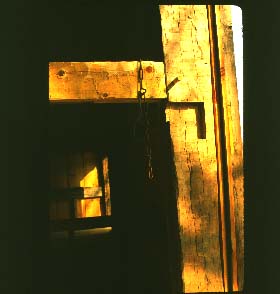TAKING
CARE OF YOUR OLD BARN
Tip #1 - Inspect It, Bottom to Top.
 It
is a good idea to thoroughly check the condition of your building at least
once a year to identify problems and make plans for any repairs. Often
simple, timely repairs can prevent thousands of dollars in damage. Recognizing
problems before they become critical will help you plan and budget for
work on the building when you need it.
It
is a good idea to thoroughly check the condition of your building at least
once a year to identify problems and make plans for any repairs. Often
simple, timely repairs can prevent thousands of dollars in damage. Recognizing
problems before they become critical will help you plan and budget for
work on the building when you need it.
Walk around the outside of
the building first. Look for evidence of leaks and dampness; use binoculars
for the upper stories and roof. Clear away overgrowth and debris. Look
at the grade around the building to see if run-off will flow into the foundation.
Has the foundation heaved? Is there dampness or rotting wood where the
structure rests on its foundation? Are the lines of the building straight?
Are walls leaning or bulging or the roof sagging? Are the eaves and roof-edge
in good condition or deteriorating? Note any peeling paint and rotting
wood, and look up and down to determine whether water might be coming down
from the roof or up from the foundation. Note any areas damaged by equipment
or storm debris.
Inside the building begin
with an inspection of the basement or foundation. See if it is sound
and identify any problems in the support for the first-story structure
and floor joists or flooring. Bring a flashlight so you can see in dark
areas. Use a screwdriver or pen-knife to probe for rot in wooden structural
members. As you move into the upper stories, keep an eye out for spoiled
hay or debris that covers dangerously rotted areas where your weight may
cause you to fall. Inspect each story from beneath before venturing up.
If something looks unsound, assume that it is until you have an accurate
assessment. Don't "test" it with your weight! Check on the inside
any problem areas you spotted on the outside of the building. Are structural
elements deteriorated inside? Is there rotted flooring or floor joists?
Look for splitting, where lighter, newly exposed wood shows a recent break.
Water will stain wood dark and some fungi will make it appear white, so
look for changes in the color of wood. Make a list of possible problem
areas.
Building professionals can help you assess the condition of your building. (For assistance in locating specialized professionals, such as contractors, architects, structural engineers, architectural conservationists, heavy-timber framers, and others, see the groups listed under "For More Information.") Most will make an initial visit to develop a cost estimate and description of what needs to be done for either a full condition assessment or actual repair work. When talking with contractors make sure you understand what they think the problem is so that you can evaluate any solutions they propose. For example, one contractor may say the foundation needs reinforcement and suggest pouring a concrete wall, while another may correctly identify a drainage problem that must be fixed before any repairs are made to the foundation.
Be wary of anyone who cannot clearly explain to you the cause of a problem and how a particular solution will correct it. Since more money can be made by selling and installing new materials than by repairing the old, carefully evaluate claims that old material "is simply worn out." Consult with at least one contractor who specializes in repairs to historic buildings, because such contractors may know of or have experience with repair techniques that others do not.
Photograph your building and its problems as a first step in planning for repairs. The photos will document the condition of your building and its problems before you do any work. They will also be helpful as you consult with others about solutions to problems you have discovered.
© 1995 Vermont Division for Historic Preservation and Vermont Housing and Conservation Board. All rights reserved.